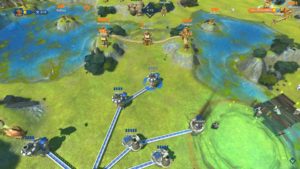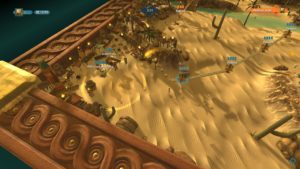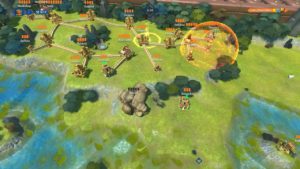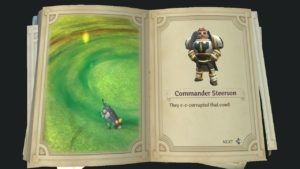
Typical strategy games, especially RTS (real-time strategy) games, rely heavily on gathering resources to build up an army and take on your foes. But what if there were no resources to gather, and instead of spending time building towers, upgrading buildings, and training units you merely had to fire projectiles and watch buildings grow almost instantly? You’d get a fast-paced tug of war full of buildings, flying and ground troops, and walls and projectiles aplenty, just like Siegecraft Commander!
It took me a while to wrap my brain around the mechanics of Siegecraft Commander, and in fact even now after playing a great deal of both campaigns I’m still at a bit of a loss with them. I’ve played some RTS games in my day like the Warcraft series, and the goal was always to balance accumulating resources with building armies, then carefully commanding a bunch of units to take on enemy units and buildings, overwhelming them with numbers and power, taking over their resources, and then continuing until the whole area was yours. In Siegecraft Commander‘s real time modes (which includes both campaigns), speed and aim are as necessary as great strategy. As I was unable to test the multiplayer aspect of the game (which allows for offline or online play and allows for either real time or turn based gameplay), this review will focus entirely on the game’s real time gameplay.

Siegecraft Commander includes two campaign modes, and each focuses on one of the two types of units you can play as in multiplayer. Voyage for Glory puts you in control of the Knights of Freemoi, battling the maybe-not-so-evil lizard people, whereas Crusade of Hope also tasks you with battling lizard people, but you play as a group of lizard people yourself and are battling corrupted brethren. The majority of the gameplay is the same, but there are some minor differences between the two armies; the lizard people, for example, can use magic that corrupts troops, among other things. The basics are the same though, even if building names are changed – you begin with a central base and expand via your cannons. Sure you can fire explosives to kill enemy units and attack towers, but you can also fire “seeds” that grow other types of towers. There’s a small tree of tower types that allow you to create barracks that automatically send troops out for glorious battle, anti-air devices that keep the nearby skies free of dragons and balloons alike, and all sorts of other towers. Towers can be built freely – aside from needing control over a handful of resources like “magic”, which only requires one for an infinite number of uses, nothing has any sort of build cost! – based on three rules. Firing a seed builds an automatic wall between the source and the target, and if there’s any sort of obstacle, including other walls and towers, building will fail. Every projectile also uses up the tower for a limited amount of time; for the most part you can use the same tower within a few seconds, but some uses can make a tower wait up to a minute or so before it can be used again. Finally, and perhaps most interestingly of all, each tower has a “parent”, and if that parent is destroyed, all of its children are destroyed. Say, for example, you create an outpost (outpost 1) which then creates another outpost (outpost 2), and outpost 2 creates a few garrisons that each have a few barracks that generate soldiers. Now let’s say something destroys outpost 2. Outpost 1 will remain, as will all of the ground troops that are still alive, but outpost 2 and all of the garrisons and barracks that it created will be destroyed as well. This makes defending towers and knowing where to strike very important, especially since the only way to get across the battlefield is by creating a big chain of towers!

What ends up happening during a match is that both sides end up reaching out toward one another like long vines, and the end result looks pretty epic since one side ends up with towers all over the place. Unfortunately, the end result of each match seemed much cooler to me than the game play. Often finishing off a group of towers ends up being a race to build an outpost and then firing explosives at their outpost before they can do the exact same thing to you. With enough strategy you can also have ground or flying units attack in unison, but it always felt like I was racing to replace the same outpost and then firing quickly toward the end of a match.
The campaign levels were intriguing though, and they’re terrific for teaching players the ropes. With both campaigns you begin with the basic towers and battle against a few small groups of enemy towers, and as you continue through the levels you unlock new towers, learn about enemy towers (and how to counter them), and deal with greater forces working against you while getting bits of an overall story. I liked that the early levels especially seemed to limit the enemy’s reach, to where they may replace towers as you destroy them, but they barely (if at all) actually try to defeat your base. This is why I was so surprised in the lizard people campaign when I was told there were two bases to conquer, and just as I defeated one of them the other had snuck over with a huge array of towers to take me out and I actually lost!

The biggest flaw I faced with the game was the difficulty with aiming new towers. There were times where I ended up trapping myself in a corner or having to make a crazy turn with numerous outposts to get through a narrow passage. Walls also prevent ground troops from passing through, including friendlies, and because you can only have 15 alive at any given time you sometimes have to murder your own troops to free up space for new ones in better positions, and then destroying your own towers to make sure they don’t spawn more soldiers. You can’t just click on a tower to destroy it, though, you actually have to hit it with at least two projectiles to take it out, which I’m sure is even more frustrating in the turn based multiplayer modes as you may burn through a dozen turns just trying to clean things up. There are also some positions in the campaign that enemies are able to take, such as on an island or on high ground, that you’re simply unable to use yourself as your walls won’t allow it. Finally, I found it very frustrating when having to create the plethora of automated defenses around outposts that it’s far too easy to accidentally have one wall touch another, resulting in failure to create the newest tower. This can be especially irritating when some of these towers take half a minute to attempt again, and even then it’s easy enough to mess up again and again.

The game is definitely unique, and it was interesting to play a much more fast-paced RTS game, let alone one where every option you have involves firing something somewhere, whether it’s an explosive, a dragon, a barrel of TNT or a repair beacon. But, at least for me, it was maybe a bit too fast paced and a little clunky overall.
SiegeCraft Commander is available for Nintendo Switch (reviewed), PlayStation 4, Xbox One, and Steam (Windows, Mac, and HTC Vive).
I received a free copy of this game in exchange for an honest review.

